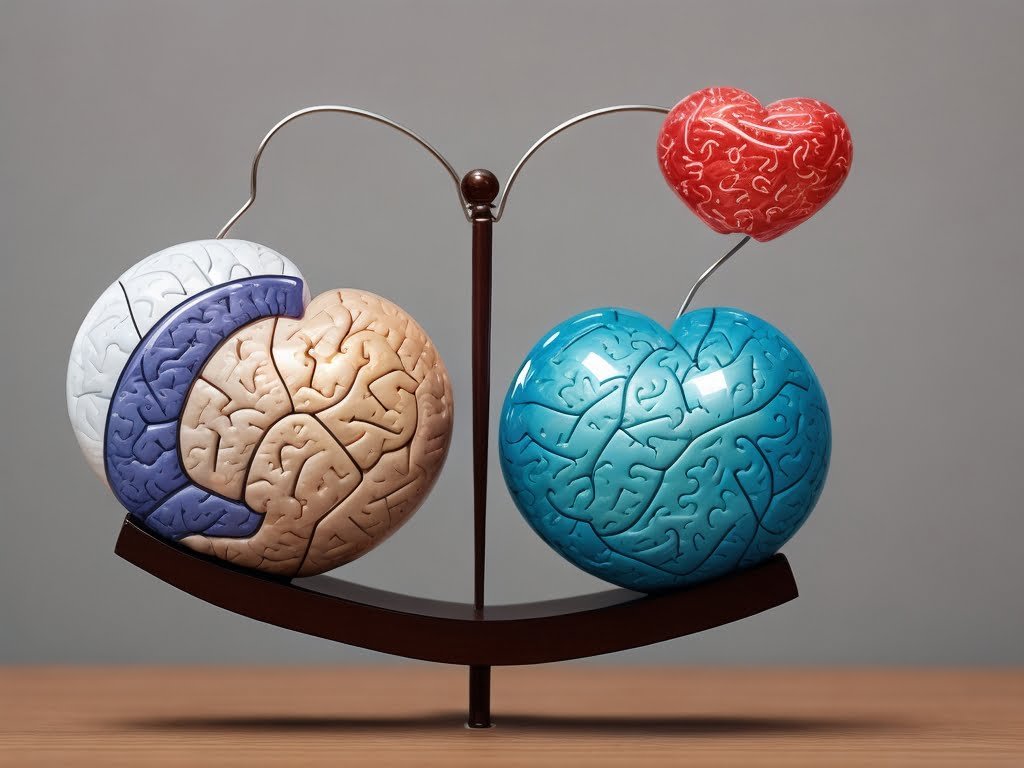7 Proven Steps to Improve Your Emotional Intelligence at Work

Introduction
In today’s fast-paced corporate world, there’s a skill that stands out, often overshadowing even technical expertise and academic qualifications. It’s not about how many facts you can memorize or even how quickly you can solve a mathematical equation. It’s about understanding, both of oneself and of others. This invaluable skill is known as Emotional Intelligence (EI). As we navigate the complexities of professional life, understanding how to improve your emotional intelligence at work becomes paramount in fostering effective communication, teamwork, and leadership.
Emotional Intelligence, at its core, is the ability to recognize, understand, and manage our own emotions while also being adept at recognizing, understanding, and influencing the emotions of those around us. It’s the subtle difference between reacting impulsively and responding thoughtfully. It’s about being attuned not just to what people say, but how they feel.
But why is EI gaining so much traction, especially in the workplace? The answer lies in the very nature of modern work environments. Unlike the jobs of yesteryears that often required repetitive tasks, today’s jobs demand interaction, collaboration, and a deep understanding of interpersonal dynamics. Here, technical skills alone don’t suffice. The ability to navigate the intricate maze of human emotions becomes paramount.
In the workplace, EI translates to better teamwork, more effective leadership, and improved interpersonal relationships. It’s the bridge that fills the gap between a disjointed team and a cohesive unit working towards a common goal. High EI individuals can sense the mood of a room, mediate conflicts before they escalate, and foster a positive work environment. They lead with empathy, motivate with understanding, and inspire trust.
In essence, while hard skills might get you the job, it’s emotional intelligence that propels you to success within it. As the lines between professional and personal lives blur, especially in the era of remote work, the importance of EI has never been more pronounced. It’s not just a skill; in many ways, it’s the future of work.
Understanding Emotional Intelligence

In a world where IQ (Intelligence Quotient) has long been the gold standard for measuring cognitive abilities, there emerges a complementary form of intelligence, one that focuses on our ability to be aware of, control, and express our emotions. This is Emotional Intelligence (EI), and its significance in both personal and professional spheres is profound.
Definition and Components of EI
Emotional Intelligence, often abbreviated as EI or EQ (Emotional Quotient), is the capacity to recognize our feelings and those of others, to differentiate between different emotions and label them appropriately, and to use this information to guide our thinking and behavior. It’s not about being emotional; it’s about being smart with our emotions.
EI can be broken down into five primary components:
- Self-awareness: This is the foundation of EI. It’s the ability to recognize and understand your moods, emotions, and drives, as well as their effect on others. It’s about knowing your strengths and weaknesses and having self-confidence.
- Self-regulation: This involves controlling or redirecting disruptive emotions and impulses and adapting to changing circumstances. It’s about being trustworthy and maintaining standards of honesty and integrity.
- Motivation: This component is characterized by a passion for work that goes beyond money and status. It’s about having a strong drive to achieve, being optimistic even in the face of failure, and being committed to the organization or cause.
- Empathy: Empathy is the ability to understand the emotional makeup of other people. It involves treating people according to their emotional reactions and being skilled in building and retaining talent.
- Social Skills: This encompasses proficiency in managing relationships and building networks. It’s about finding common ground, building rapport, and being persuasive and influential.
Each of these components plays a crucial role in determining our overall emotional intelligence. While some people naturally possess a high EI, others can develop and enhance it through learning and practice.
The Neuroscience Behind EI
To truly grasp the concept of Emotional Intelligence, it’s essential to delve into the realm of neuroscience. Our brain, a complex organ with billions of neurons, plays a pivotal role in shaping our emotional responses.
The limbic system, a group of interconnected structures near the center of the brain, is the epicenter of our emotions. Two key parts of the limbic system involved in EI are the amygdala and the prefrontal cortex.
- Amygdala: Often referred to as the “emotional sentinel,” the amygdala plays a crucial role in emotional responses. It’s responsible for the instantaneous emotional reaction we have to situations, often before our rational brain has time to react.
- Prefrontal Cortex: This is the rational part of our brain, responsible for decision-making, reasoning, and problem-solving. It’s where we process emotional input and decide how to act on it.
The interplay between the amygdala and the prefrontal cortex is vital in emotional intelligence. When we’re faced with an emotionally charged situation, the amygdala can trigger a rapid, instinctive response, often referred to as the “fight or flight” reaction. However, in many modern scenarios, these instinctive reactions may not be the most appropriate. This is where the prefrontal cortex comes in, processing the emotional input, and helping us respond in a more measured, rational manner.
In essence, high emotional intelligence is often a sign of a well-balanced interplay between the amygdala and the prefrontal cortex. It’s about allowing our emotions to inform our decisions, without letting them dictate our actions.
In conclusion, understanding the neuroscience behind EI not only gives us insights into why we react the way we do but also offers clues on how we can enhance our emotional intelligence, making more informed, balanced decisions in both our personal and professional lives.
The Significance of Emotional Intelligence in Professional Settings

In the modern workplace, where collaboration, communication, and adaptability are more crucial than ever, Emotional Intelligence (EI) stands out as a pivotal skill. It’s no longer just about how well you can do a task, but how you navigate interpersonal dynamics, handle stress, and foster positive environments. Let’s delve into the profound significance of EI in professional settings.
Benefits of High EI for Individuals
- Enhanced Communication: Individuals with high EI are adept at expressing themselves, ensuring their ideas and feelings are understood. They’re also active listeners, picking up on non-verbal cues and understanding the emotions behind words.
- Better Decision Making: Emotionally intelligent individuals can separate emotions from facts. They consider the emotional and logical aspects of a situation, leading to well-rounded decisions.
- Stress Management: High EI individuals recognize their emotional triggers and have strategies to cope, ensuring they remain calm and effective even under pressure.
- Improved Relationships: With an innate ability to understand and empathize with others, these individuals build strong, authentic relationships, fostering trust and rapport.
- Career Advancement: Their ability to navigate complex interpersonal dynamics, lead teams, and handle challenging situations often makes them prime candidates for leadership roles.
Advantages for Organizations and Teams
- Enhanced Team Cohesion: Teams with emotionally intelligent members tend to have better collaboration, understanding each other’s strengths and weaknesses, and working synergistically.
- Reduced Conflicts: High EI leads to effective conflict resolution. Instead of escalating disagreements, they’re resolved amicably, ensuring a positive work environment.
- Increased Productivity: When employees feel understood and valued, they’re more motivated, leading to increased efficiency and output.
- Leadership Development: Emotionally intelligent employees often rise to leadership positions, bringing their unique skills to guide, motivate, and inspire teams.
- Employee Retention: A positive work environment, characterized by understanding, empathy, and effective communication, reduces turnover rates. Employees feel valued and are less likely to seek opportunities elsewhere.
Real-world Examples of EI’s Impact
Example 1: The Empathetic Manager: Sarah, a project manager in a tech firm, was known for her ability to get the best out of her team. When one of her team members, Mark, started missing deadlines and seemed disengaged, instead of reprimanding him, she took him aside to understand the issue. She discovered he was going through a tough personal situation. Recognizing this, she adjusted his workload and offered support. Mark, feeling understood and valued, soon bounced back, and his performance improved. Sarah’s EI not only prevented a potential HR issue but also ensured the team’s cohesion and productivity remained intact.
Example 2: The Adaptable Sales Team: A sales team at a pharmaceutical company was struggling with a new product launch. The initial feedback from doctors was not promising. Instead of pushing the same sales pitch, the team, led by an emotionally intelligent leader, decided to listen actively to the doctors’ concerns. They adapted their approach, addressing the concerns in their pitch, and soon saw a significant uptick in sales. Their ability to understand and adapt to their clients’ emotions made all the difference.
Example 3: The Conflict Resolver: In a design agency, two lead designers, Jake and Mia, had contrasting views on a project. Tensions escalated, affecting the entire team’s morale. The department head, known for his high EI, intervened. Instead of taking sides, he facilitated a meeting where both Jake and Mia could express their views and emotions. Recognizing the value in both perspectives, they combined their ideas, leading to a design that was lauded by the client. The leader’s ability to handle the situation ensured not only the project’s success but also maintained a positive team environment.
Self-assessment: Gauging Your Current Emotional Intelligence

Before embarking on any journey of self-improvement, it’s crucial to know where you stand. The same applies to enhancing your Emotional Intelligence (EI). By assessing your current EI, you gain insights into your strengths and areas that might need some attention. Let’s delve into the process of self-assessment and its significance.
Importance of Self-awareness
Self-awareness is often considered the cornerstone of emotional intelligence. It’s the introspective process of understanding your emotions, recognizing how they affect your thoughts and behavior, and discerning between your strengths and weaknesses.
Why is this so crucial? Because without self-awareness, we operate on autopilot. We react to situations without truly understanding why. By being self-aware, we can:
- Recognize Emotional Triggers: Understand what situations or actions ignite strong emotional reactions, allowing us to better navigate or avoid them.
- Make Informed Decisions: By understanding our emotional reactions, we can make decisions that are not just reactive but well-thought-out.
- Enhance Relationships: Recognizing our emotions and understanding their origin helps us communicate more effectively, fostering better personal and professional relationships.
Popular Tools and Tests for EI Assessment
There’s a plethora of tools and tests available to gauge your emotional intelligence. Here are some of the most popular ones:
- Mayer-Salovey-Caruso Emotional Intelligence Test (MSCEIT): Based on the model by Mayer and Salovey, this test measures your ability to perceive, use, understand, and manage emotions.
- Emotional Intelligence Appraisal: Offered by TalentSmart, this test provides a snapshot of your EI, highlighting areas of strength and potential improvement.
- Bar-On Emotional Quotient Inventory (EQ-i): This self-report test evaluates various areas of emotional and social functioning.
While these tools offer valuable insights, it’s essential to approach them with an open mind. Remember, the goal isn’t to achieve a “perfect score” but to gain a deeper understanding of yourself.
Interpreting Your EI Scores
Once you’ve taken an EI test, you’ll receive a score, often accompanied by a detailed report. But what do these numbers mean?
- Understand the Components: Most EI tests break down your score into different components, such as self-awareness, self-regulation, motivation, empathy, and social skills. Look at each section to understand where you excel and where there’s room for growth.
- Percentiles: Often, your score will be presented as a percentile, showing how you compare to others who’ve taken the test. For instance, if you’re in the 70th percentile, you scored higher than 70% of the test-takers.
- Feedback and Recommendations: Most assessments provide feedback based on your scores, offering actionable recommendations to enhance your EI.
It’s essential to approach these scores with a growth mindset. Instead of seeing them as a definitive measure of your abilities, view them as a starting point. Emotional intelligence, unlike IQ, can be developed and enhanced with conscious effort and practice.
The 7 Proven Steps to Boost Emotional Intelligence

Step 1: Cultivating Self-awareness
The journey to enhancing Emotional Intelligence (EI) begins with cultivating self-awareness. It’s the process of turning the lens inward, understanding your emotions, and recognizing how they influence your thoughts, decisions, and interactions. Let’s explore some techniques to foster self-awareness and the pivotal role of journaling in this endeavor.
Techniques for Introspection
1. Mindfulness Meditation: This practice involves sitting quietly and focusing on the present moment. By paying attention to your breath, bodily sensations, and thoughts, you become more attuned to your emotional state. Over time, mindfulness can help you recognize and understand your emotional triggers.
2. Feedback Solicitation: Sometimes, we’re blind to our behaviors and reactions. Seeking feedback from trusted colleagues, friends, or mentors can provide insights into how our emotions manifest in our actions.
3. Reflective Practice: Dedicate a few minutes each day to reflect on your actions, decisions, and emotions. Think about situations that evoked strong emotions: What triggered them? How did you react? What could you have done differently?
The Role of Journaling
Journaling is a powerful tool in the quest for self-awareness. By putting pen to paper, you externalize your emotions, making them tangible and easier to analyze. Here’s how journaling aids in cultivating self-awareness:
1. Emotional Tracking: By jotting down your feelings daily, you can start to see patterns. Maybe you notice you’re always irritable after meetings with a particular colleague, or perhaps you feel elated after your morning workout. Recognizing these patterns can help you anticipate and manage your emotions better.
2. Problem-solving: Writing about challenges or conflicts allows you to dissect them, understand your role in them, and think of potential solutions or ways to handle similar situations in the future.
3. Clarity: Often, our minds are a whirlwind of thoughts and emotions. Journaling helps declutter the mind, providing clarity and perspective.
Step 2: Developing Empathy
Empathy, often described as the ability to “walk a mile in someone else’s shoes,” is a cornerstone of Emotional Intelligence (EI). It goes beyond mere sympathy, which is feeling for someone, to truly feeling with them. Developing empathy allows us to connect deeply with others, fostering understanding and building stronger relationships. Let’s delve into the nuances of understanding others’ perspectives and the transformative power of active listening.
Understanding Others’ Perspectives
1. Open-mindedness: Approach situations and interactions with an open mind. Instead of jumping to conclusions or making judgments, try to see things from the other person’s viewpoint. This doesn’t mean you have to agree, but understanding their perspective can lead to more meaningful interactions.
2. Ask Open-ended Questions: Instead of making assumptions, ask questions that allow the other person to express themselves. Questions like “How did that make you feel?” or “What led you to that decision?” can provide insights into their thought processes and emotions.
3. Avoid Projecting: It’s easy to project our feelings and experiences onto others. Remember that everyone’s journey is unique. Just because you might react a certain way doesn’t mean others will too.
The Power of Active Listening
Active listening is more than just hearing words; it’s about understanding and interpreting the emotions and intentions behind them.
1. Full Attention: When someone is speaking, give them your undivided attention. Put away distractions, maintain eye contact, and focus on the speaker.
2. Non-verbal Cues: Pay attention to body language, tone of voice, and facial expressions. Often, these non-verbal cues convey more than words.
3. Reflect and Clarify: After the person has spoken, reflect back what you’ve heard to ensure understanding. For instance, “So, what you’re saying is…” This not only shows you’re listening but also ensures you’ve grasped the essence of their message.
Step 3: Mastering Effective Communication
Communication is the bridge that connects individuals, fostering understanding, collaboration, and unity. While it might seem straightforward, effective communication goes beyond merely speaking or writing. It’s about conveying thoughts, ideas, and emotions in a manner that’s clear, concise, and comprehensible. Let’s explore the nuances of articulating thoughts clearly and the indispensable role of feedback in communication.
Articulating Thoughts Clearly
1. Structure and Clarity: Before communicating, organize your thoughts. Whether it’s a presentation, an email, or a casual conversation, having a clear structure helps convey your message effectively. Start with the main idea, followed by supporting points, and conclude succinctly.
2. Avoid Jargon: Especially in professional settings, it’s easy to fall into the trap of using industry-specific jargon. While it might make sense to you, it could alienate or confuse others. Aim for simplicity and clarity.
3. Be Present: Effective communication is a two-way street. Be present in the conversation, actively listen, and respond appropriately. It shows respect and ensures that the communication is collaborative.
The Importance of Feedback
1. Ensures Understanding: Feedback acts as a mirror, reflecting your message’s effectiveness. By seeking feedback, you can gauge whether your message was understood as intended.
2. Encourages Growth: Constructive feedback, whether positive or negative, provides insights into areas of improvement. It’s a tool for personal and professional growth, helping refine communication skills.
3. Builds Trust: Open channels of feedback foster an environment of trust. It shows that you value others’ opinions and are open to dialogue, enhancing interpersonal relationships.
Step 4: Emotion Regulation Techniques
Emotions, while powerful and essential, can sometimes become overwhelming, leading to impulsive reactions or clouded judgment. Emotion regulation is the process of managing and responding to emotional experiences in a manner that’s constructive and balanced. Let’s delve into some effective techniques, from mindfulness to handling stress, that can aid in emotion regulation.
Mindfulness and Meditation
1. Grounding in the Present: Mindfulness is the practice of being fully present in the moment, without judgment. By focusing on the here and now, you can observe your emotions without getting swept away by them.
2. Breathing Exercises: Simple breathing techniques, like deep diaphragmatic breathing or the 4-7-8 technique, can help calm the mind, reducing emotional intensity.
3. Guided Meditation: Using guided meditation apps or sessions can help you navigate emotional landscapes, recognizing triggers, and developing responses that are measured and thoughtful.
Handling Stress and Pressure
1. Break Tasks into Steps: When faced with a daunting task or situation, break it down into smaller, manageable steps. This reduces the feeling of being overwhelmed and provides a clear path forward.
2. Physical Activity: Engaging in physical activities, whether it’s a brisk walk, yoga, or a gym session, can help release pent-up emotions and reduce stress. Exercise releases endorphins, which are natural mood lifters.
3. Seek Support: Talk to someone you trust, whether it’s a friend, family member, or therapist. Sharing your feelings and concerns can provide a fresh perspective and reduce the emotional burden.
Step 5: Building Resilience
Resilience is the ability to bounce back from adversity, to adapt and move forward in the face of challenges. It’s a quality that not only helps us overcome setbacks but also fosters growth and development. In the context of Emotional Intelligence, resilience plays a pivotal role in how we handle challenges and setbacks. Let’s explore the facets of building resilience, from overcoming obstacles to embracing a growth mindset.
Overcoming Challenges and Setbacks
1. Acceptance: The first step in building resilience is accepting that setbacks are a natural part of life. Instead of resisting or denying them, embrace them as learning opportunities.
2. Problem-solving: When faced with a challenge, instead of getting overwhelmed, break it down. Identify the root cause, brainstorm solutions, and take actionable steps to address it.
3. Seek Support: Remember, you don’t have to face challenges alone. Lean on your support system, whether it’s friends, family, or professionals. Sharing your concerns and seeking advice can provide new perspectives and strategies.
The Growth Mindset
Coined by psychologist Carol Dweck, the growth mindset is the belief that abilities and intelligence can be developed through dedication and hard work. It’s a contrast to a fixed mindset, where individuals believe their talents are innate.
1. Embrace Challenges: Individuals with a growth mindset see challenges as opportunities to grow. Instead of avoiding them, they embrace them, knowing that they offer learning experiences.
2. Learn from Criticism: Instead of getting defensive or disheartened by criticism, use it as feedback. Understand the areas of improvement and work on them.
3. Celebrate Others’ Success: Instead of feeling threatened by others’ success, celebrate it. Learn from their journey, and use it as motivation for your own growth.
Step 6: Continuous Learning and Feedback

The journey of Emotional Intelligence (EI) doesn’t have a final destination; it’s an ongoing process of growth, adaptation, and refinement. Just as the world around us evolves, so do our emotions and how we handle them. Central to this journey are continuous learning and feedback. Let’s delve into the importance of embracing constructive criticism and the concept of lifelong learning in the realm of EI.
Embracing Constructive Criticism
1. A Tool for Growth: Constructive criticism, when delivered with care and genuine intent, provides insights into areas of improvement. Instead of viewing it as an attack, see it as a roadmap highlighting areas that can be enhanced.
2. Building Stronger Relationships: By being open to feedback, you show that you value others’ opinions and are willing to grow. This openness fosters trust and strengthens interpersonal relationships.
3. Enhancing Self-awareness: Feedback often sheds light on blind spots – aspects of ourselves we might be unaware of. By understanding and addressing these areas, we enhance our self-awareness, a cornerstone of EI.
Lifelong Learning in EI
1. Evolving Emotional Landscape: As we go through different life stages, face varied challenges, and experience a spectrum of emotions, our EI needs to adapt. Continuous learning ensures we’re equipped to handle these evolving emotional landscapes.
2. New Research and Techniques: The field of Emotional Intelligence is dynamic, with new research, techniques, and tools emerging regularly. Staying updated ensures we have the latest knowledge and strategies at our disposal.
3. Personal and Professional Growth: EI plays a pivotal role in both personal and professional spheres. By committing to lifelong learning, we ensure that we’re not just growing as individuals but also enhancing our professional relationships and prospects.
Step 7: Fostering Healthy Relationships
At the heart of Emotional Intelligence (EI) lies the ability to foster and nurture relationships. Whether in personal or professional spheres, healthy relationships are the bedrock of success, happiness, and fulfillment. They provide support, open doors to opportunities, and enrich our lives in myriad ways. Let’s explore the nuances of networking and the art of building trust and rapport, essential components of fostering healthy relationships.
Networking Tips
1. Genuine Interest: When networking, show genuine interest in the other person. Ask open-ended questions, listen actively, and engage in meaningful conversations rather than just exchanging business cards.
2. Quality Over Quantity: It’s not about how many contacts you have, but the quality of those connections. Focus on building deep, meaningful relationships rather than spreading yourself thin.
3. Follow Up: After meeting someone, send a follow-up message or email. It shows you value the connection and are keen on building the relationship.
4. Offer Value: Networking is a two-way street. Think about how you can offer value, whether it’s sharing knowledge, providing a referral, or offering support.
Building Trust and Rapport
1. Consistency: Trust is built over time through consistent actions. Be reliable, keep your promises, and show up when it matters.
2. Active Listening: Pay attention to what the other person is saying, ask clarifying questions, and show empathy. It fosters understanding and shows you care.
3. Open Communication: Be transparent in your communication. Address concerns, provide feedback, and be open to receiving the same.
4. Shared Experiences: Spend time together, whether it’s working on a project, attending an event, or simply grabbing a coffee. Shared experiences create bonds and build rapport.
Semantically Relevant Topics
Emotional Intelligence vs. Cognitive Intelligence

In the realm of personal and professional development, two types of intelligence often come into focus: Emotional Intelligence (EI) and Cognitive Intelligence, commonly referred to as Intelligence Quotient (IQ). While both are integral to an individual’s overall intelligence profile, they serve different functions and can be more or less crucial depending on the scenario. Let’s delve into their differences, intersections, and the situations where EI might overshadow IQ.
Differences and Intersections
1. Nature of Intelligence:
- EI: Refers to the ability to recognize, understand, manage, and effectively express one’s own and others’ emotions. It encompasses skills like empathy, self-awareness, and interpersonal effectiveness.
- IQ: Represents cognitive abilities such as logical reasoning, problem-solving, mathematical skills, and linguistic prowess. It’s often measured through standardized tests and remains relatively stable throughout life.
2. Development and Flexibility:
- EI: Can be cultivated and enhanced over time through experiences, introspection, and training.
- IQ: While certain cognitive skills can be honed, the baseline IQ remains relatively constant.
3. Intersections: Both EI and IQ intersect in areas like problem-solving, decision-making, and interpersonal interactions. A high IQ individual with strong EI can leverage their cognitive abilities while being attuned to emotional undercurrents, leading to more holistic solutions and strategies.
Why EI can be More Crucial than IQ in Certain Scenarios
1. Leadership and Team Dynamics: In leadership roles or team settings, understanding and managing emotions can be pivotal. Leaders with high EI can motivate teams, navigate conflicts, and foster a positive work environment, leading to increased productivity and morale.
2. Customer Relations: In roles that require direct customer interaction, EI can be the difference between a satisfied customer and a lost opportunity. Understanding customer emotions and needs can lead to better service and long-term loyalty.
3. Personal Relationships: While cognitive intelligence is essential, personal relationships thrive on emotional connection, understanding, and empathy – all facets of EI.
4. Stressful Situations: In high-pressure scenarios, emotional regulation, a component of EI, can be more crucial than cognitive skills. Being able to manage one’s emotions can lead to clearer decision-making and better outcomes.
The Role of EI in Leadership
Leadership is not just about strategic vision or decision-making prowess; it’s also about connecting with people, understanding their motivations, and guiding them towards collective goals. Emotional Intelligence (EI) plays a pivotal role in shaping effective leaders, enabling them to navigate the complex landscape of interpersonal relationships and organizational dynamics. Let’s explore how EI molds influential leaders and delve into some case studies of renowned leaders known for their high EI.
How EI Shapes Effective Leaders
1. Empathy and Understanding: Leaders with high EI can put themselves in their team members’ shoes, understanding their concerns, aspirations, and challenges. This empathy fosters trust and loyalty, essential for team cohesion.
2. Decision Making: While data and logic are crucial, many leadership decisions also involve human factors. EI equips leaders to consider emotional undercurrents, ensuring decisions are holistic and well-rounded.
3. Conflict Resolution: Disagreements are inevitable in any organization. Leaders with strong EI can navigate these conflicts, understanding the emotional drivers behind them and finding solutions that address the root causes.
4. Motivation and Inspiration: An emotionally intelligent leader can recognize what drives their team, tapping into these motivations to inspire and encourage peak performance.
Case Studies of Renowned Leaders with High EI
1. Nelson Mandela: Mandela’s leadership was marked by his ability to understand and connect with people from all walks of life. His empathy and ability to forgive, even those who imprisoned him, showcased his immense EI. He united a divided nation, not through force, but through understanding and reconciliation.
2. Indra Nooyi: As the former CEO of PepsiCo, Nooyi was known for her empathetic leadership style. She often wrote letters to the parents of her senior executives, acknowledging the upbringing that led to their successes. This personal touch, understanding the cultural and emotional importance of such gestures, showcased her EI.
3. Richard Branson: The founder of the Virgin Group, Branson is known for his people-centric approach to business. He believes that taking care of employees ensures they take care of the business. His ability to connect with and motivate his workforce showcases his high EI.
Emotional Intelligence in Team Dynamics
In the collaborative world of modern workplaces, teams are the engines that drive organizational success. The dynamics within these teams, influenced significantly by Emotional Intelligence (EI), play a pivotal role in determining their effectiveness and productivity. Let’s explore how EI impacts team cohesion and performance and delve into strategies for cultivating emotionally intelligent teams.
EI’s Influence on Team Cohesion and Performance
1. Enhanced Collaboration: Teams with high collective EI tend to have members who understand and respect each other’s emotions and perspectives. This mutual understanding fosters a collaborative spirit, where members work together seamlessly.
2. Conflict Resolution: Disagreements are natural in team settings. However, teams with strong EI can navigate these conflicts constructively, addressing the root emotional causes and finding solutions that satisfy all parties.
3. Motivation and Morale: Emotionally intelligent leaders can tap into the individual motivations of team members, boosting morale and driving performance. When team members feel understood and valued, their commitment and productivity soar.
4. Adaptability: Teams with high EI are more adaptable to change. They can navigate the emotional landscape of transitions, ensuring that changes are smooth and that team members remain engaged.
Strategies for Building Emotionally Intelligent Teams
1. Training and Workshops: Invest in EI training sessions and workshops. These can equip team members with tools and techniques to understand and manage their emotions and those of their colleagues.
2. Open Communication: Foster an environment where team members feel safe expressing their feelings and concerns. Regular check-ins and feedback sessions can facilitate this.
3. Lead by Example: Leaders and managers should embody EI in their interactions, setting a tone for the entire team. When leaders showcase empathy, active listening, and emotional regulation, team members are more likely to emulate these behaviors.
4. Team-building Activities: Organize activities that allow team members to connect on a personal level. These can help break down barriers and foster understanding and trust.
Emotional Intelligence is a linchpin in team dynamics, influencing everything from collaboration to adaptability. By understanding its importance and actively cultivating it, organizations can build high-performing teams that drive success.
Conclusion and Call to Action
As we’ve journeyed through the multifaceted world of Emotional Intelligence (EI), it’s evident that EI is not just a buzzword or a fleeting trend. It’s a foundational skill, deeply intertwined with our personal and professional successes. From shaping effective leaders to fostering high-performing teams, EI’s influence is pervasive and profound.
Recap and Importance of Continuous EI Development
Emotional Intelligence goes beyond mere emotional awareness. It encompasses the ability to understand, manage, and effectively express our emotions while also navigating the emotions of those around us. In professional settings, EI plays a pivotal role in leadership, team dynamics, decision-making, and conflict resolution. On a personal front, it enhances our relationships, resilience, and overall well-being.
However, like any skill, EI isn’t static. The emotional landscapes we navigate evolve as we move through different life stages, face varied challenges, and interact with diverse individuals. Thus, continuous development and refinement of our EI are crucial. It ensures that our emotional skills remain relevant, sharp, and a true asset in every situation.
Encouraging Readers to Start Their EI Journey
To all our readers, if you haven’t already embarked on your EI journey, now is the perfect time. The benefits of honing your Emotional Intelligence are manifold, and the ripple effects can be seen in every sphere of life. Start with self-awareness, understanding your emotions, and their triggers. Gradually expand to empathy, understanding others, and building meaningful connections.
Remember, every interaction, every challenge, and every emotion you experience is an opportunity to learn and grow. Embrace them, learn from them, and let them guide you on your EI journey.
Call to Action: Begin today. Invest in EI workshops, read books, or simply start with introspection. Every step you take towards enhancing your Emotional Intelligence is a step towards a more fulfilling, successful, and enriched life.




